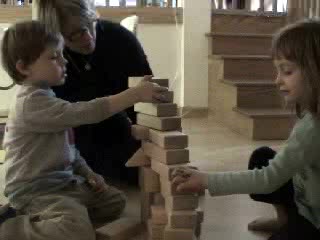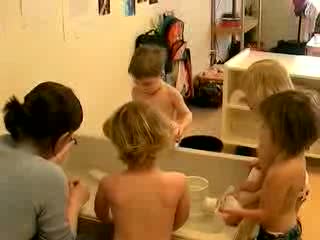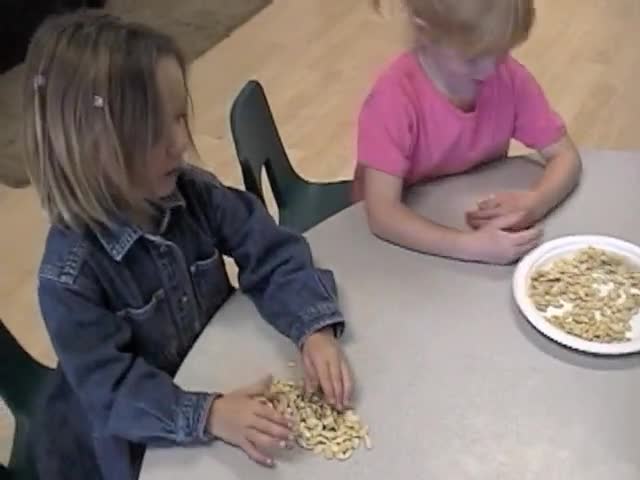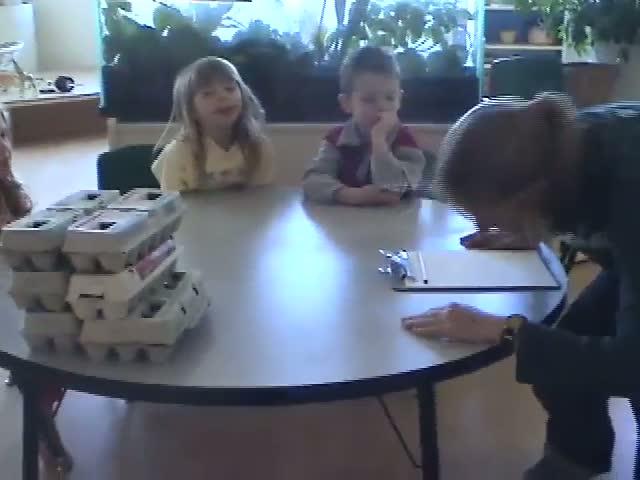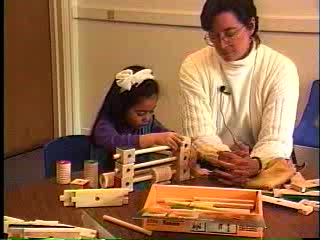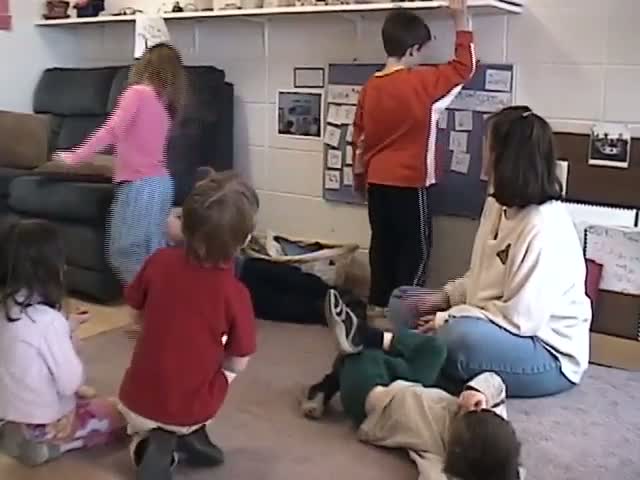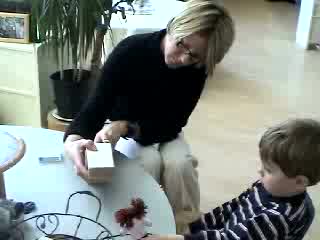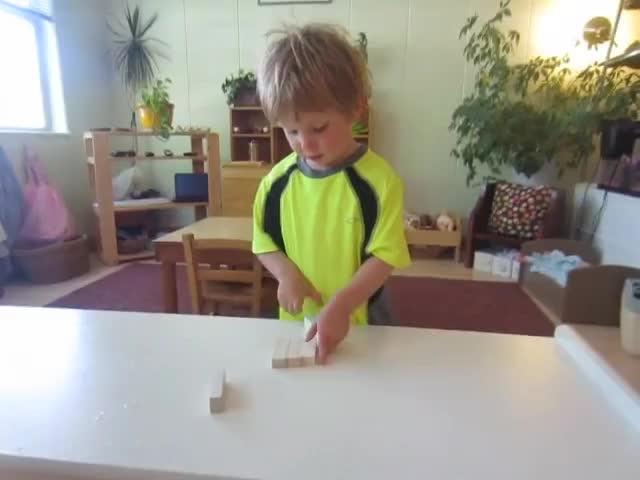Math: Counting 10 videos
In the videos that follow, you will see children practicing the number sequence while adding food coloring to their classroom water table, the strategies children invent to get an accurate count of a large, unknown quantity of objects while reducing the labor involved; and how these strategies are later revised, young children at different stages in their understanding of cardinal value, how a five-year-old girl demonstrates her understanding of the difficult concept, “counting on” while counting blocks in a mirror.
In the first video, Coloring Water, six two-year-olds and their teacher, experiment with mixing food coloring in water. Notice that the teacher asks the children how much food coloring to add and the children repeatedly answer by saying, “Ten.†What do you think is the significance of the number, “ten,†for the children? Observe how the teacher counts out loud as she adds each drop of color to the water. In the second round, the children choose the color red, and the teacher invites them to help her count (00:52). In your opinion, are the children thinking about the quantity of drops represented by the number, “ten,†or is it more likely that the children are practicing the number sequence as they count along with their teacher? Later on in the video, the children again decide to add red food coloring to the water. When no color change is observed, the teacher says, “Okay, we already did four, so here’s five and she adds a single drop of color to the water (03:40). As she does so, a child counts, “one,†as if to begin a new counting sequence (03:42). What do you think may be a more effective strategy for introducing the concept of “counting on†(N + 1)? What strategies do you think the teacher could use to help the children determine if ten drops of food coloring represents a lot or a little?
The second item in this playlist, Math Play Begins Before Counting, is a special video presentation called a videative. We have included this videative because it effectively shows how the concepts of some, and more, and many are ways young children begin using numbers by comparing amounts.
In the third video, Pumpkin Seeds and Checkers: A Math Conundrum, kindergarten children decide they want to know the total number of pumpkin seeds that came from four Halloween pumpkins. And on another day, they need to know how many checkers they have yet to make for the checkerboards they are giving as gifts. These two experiences illustrate the children’s cleverness as well as the teacher’s willingness to allow the children to apply a strategy to see how it does not work. Jensen (the child on the left in the denim dress) understands that if you have a large number of objects to count then you can split up the objects into more manageable amounts and count them separately. Jensen also understands the idea that parts make up a whole. She explains, “We could all have our own plate to put these on and tell us how many seeds we have and then, we could equal those up and put them together. And then we’d know how many we have.†Jensen begin to count by saying, “One hundred and one, one hundred and two, one hundred and three…†(01:00). Her theory is that if you have a large number of objects in a pile, you can estimate their amount and begin counting from the estimation. This is a misconception on Jensen’s part, for if you start with an estimated amount you will not be able to have an accurate count of the total number of pumpkin seeds. Jensen counts the seeds in tens beginning with one hundred. She understands the idea of “base tenâ€: for every ten items counted, you must add one number in the ten’s spot. Jensen’s “base ten†system breaks down, however, when another zero is added to the equation. Instead of adding one to the ten’s spot, Jensen adds one to the number in front. Jensen counts, “100, 101, 102, 103…109, 200, 201…209, 300, 301….†In a later experience, Jensen revisits her strategy of making a large quantity of objects more manageable to count by dividing them up onto separate plates, then adding the plates together. Jensen understands that two checkers on each plate act as a single unit. The use of these units of two allows her counting to follow a pattern. For example, Jensen explains, “Two on each plate is a little faster. I was gonna put, I was gonna change my mind and put all these (remaining checkers) one more but then I found out some of them (the plates) might not have the same number, so I’m doing two at a time.†What Jensen does not realize is that she can use multiplication in order to come up with the total number of checkers.
In the fourth video, Counting to Determine Quantity, three children work with their teacher to assign prices to cartons of eggs from the pretend store in their classroom. The children begin by thinking about how they can use the size of the cartons to calculate price. For example, Emily says, “How ‘bout we do it by fat? By fat and skinny?†(00:43) The teacher asks, “Which one do you think would cost the most money?†and the children point to the larger egg carton. The teacher then asks, “Which one do you think would cost the least money?†Emily says, “All of these†as she points to the five smaller egg cartons and explains how they are equivalent: “They’re all skinny.†Then the children open the egg cartons and discover the holes inside. The rows of identical holes encourage the children to shift from thinking about size to considering how quantity relates to price. The teacher supports the children’s new interest by asking, “How many eggs will fit in these?†The children take turns counting and we soon learn that they at different stages of understanding cardinal value. Emily points to each hole as she counts, “1, 2, 3, 4, … 12!†The emphasis she adds by using a higher pitch to say, “12,†suggests Emily understands the last number has both an ordinal value (set place in the number sequence) and a cardinal value (represents the total number in the set). Sean joins Emily and begins counting the holes in his egg carton. He points to the second hole up from the bottom right and says, “Five†at the same time as Emily. He counts, “5, 6, 7, 8, 9, 10, 11, 12, 13, 14, (skips 15), 16.†With the teacher’s encouragement Sean counts again and gets a total of 13 holes. Later, the children take turns counting the holes in the larger egg carton: Sean gets a total of 19, Emily gets a total of 18, and Mackenzie gets a total of 28 holes. Notice that the children do not comment about or seem to recognize the illogic of getting a different total on different counts. In addition, the teacher does not revisit counting the large egg carton with them. Why not give the child a more tangible way to keep track of the holes he or she has counted? Do you think the children leave this experience thinking that we can name this set anything they want? What is cardinal value to a five year old? Is it just the name you give to something after you poke at it for a little while?
In the fifth video, Counting Blocks in a Mirror, the teacher invites Ria to consider both the set of real wooden blocks and the set of blocks reflected in the mirror. Notice that Ria guides her own ability to maintain a one to one correspondence between each block and each numeral she says by pointing as she counts. Ria counts, “One, two, three…†for the blocks that she sees in the mirror, “Four, five, six…†for the wooden blocks that she has physically placed. When Ria decides to “add one more,†she demonstrates her understanding of “counting on†(N+1). She adds a fourth block to the initial stack of three without having to recount the original set. Ria explains to her teacher, “If you have three and you add one more then you get four!†(00:44). Ria understands that the total, or “cardinal†value of three can be treated as a place to restart counting for a new total. As the teacher invites Ria to consider both the set of real wooden blocks and the set of blocks reflected in the mirror, Ria grapples with the total number of blocks that she perceives. Notice she says, “seven,†and points to the space where she plans to add the next block (00:55). Perhaps because Ria is busy thinking about adding a block to the top of the stack, she does not include in her count the reflected block (eight) that will be created by the additional placement. After adding an extra layer of blocks to her structure, the teacher asks Ria to count “the ones in the mirror and the ones on top.†Notice that Ria does not “count on†from the total value of the mirrored set to reach the total number of blocks. When Ria pauses after counting the four blocks in the mirror, she shows that she is thinking about the blocks as two separate sets to be added together. She explains, “Four blocks it looks like in the mirror but if you add them altogether it gets, one, two, three…eight. It gets to be eight, Marybeth!â€
In the sixth video, Calendar, study how the children demonstrate an emerging understanding about the conventions of the calendar, number recognition, sequence and counting.
In the seventh video, Building Stairs with Blocks, Jack gains experience with the concept of a threshold quantity, which adds function to a cardinal value. He discovers that when you get to four (blocks), something happens.
In the eighth video, Stacking Tires, Jensen counts the number of tires she has stacked as a strategy for marking her goal.
In the ninth video, Math-Combining Sets, two four-year-old boys count small sets of blocks and then combine them to double the count.
